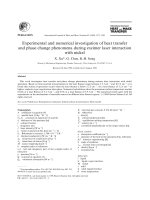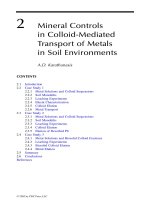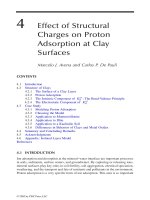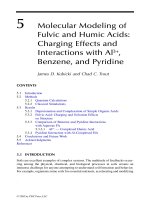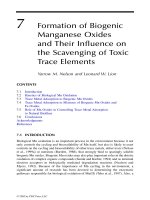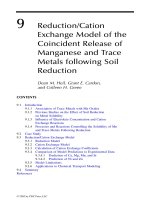Experimental and numerical modelling of spudcan penetration in stiff clay overlying soft clay
Bạn đang xem bản rút gọn của tài liệu. Xem và tải ngay bản đầy đủ của tài liệu tại đây (21.83 MB, 231 trang )
EXPERIMENTAL AND NUMERICAL MODELLING OF
SPUDCAN PENETRATION IN STIFF CLAY OVERLYING
SOFT CLAY
SINDHU TJAHYONO
NATIONAL UNIVERSITY OF SINGAPORE
2011
EXPERIMENTAL AND NUMERICAL MODELLING OF
SPUDCAN PENETRATION IN STIFF CLAY OVERLYING
SOFT CLAY
SINDHU TJAHYONO
(B.Eng., NUS)
A THESIS SUBMITTED
FOR THE DEGREE OF DOCTOR OF PHILOSOPHY
DEPARTMENT OF CIVIL ENGINEERING
NATIONAL UNIVERSITY OF SINGAPORE
2011
i
Acknowledgements
First and foremost, I thank my advisers Prof Leung Chun Fai and Prof Chow Yean
Khow for their constant support and critical guidance throughout the course of my
PhD study. Without them, this thesis would not materialise. I also acknowledge the
financial support in the form of Research Scholarship provided by NUS for my PhD
study. I also thank Dr Tho Kee Kiat for his valuable feedbacks especially on the
numerical part of this thesis. And not forgetting the centrifuge and geotechnical lab
staff Mr Wong Chew Yuen, Mr Tan Lye Heng, Dr Shen Rui Fu, Mr John Choy, Mdm
Jamilah and Mr Lam Foo for their assistance in the experimental work presented in
this thesis.
Thanks also to fellow members of the offshore geotechnical research group including
Prof Palmer, Dr Purwana Okky, Dr Zhou Xiaoxian, Dr Xie Yi, Dr Teh Kar Lu, Dr Gan
Cheng Ti, Eddy Hu, Cisy and Zongrui, for their constant encouragements and
enriching communications. And also to the rest of fellow geotechnical researchers: Dr
Chin Keng Ghee, Dr Pang Chin Hong, Dr Cheng Yonggang, Dr Karthikeyan, Dr Chen
Xi, Dr Phoon Hung Leong, Dr Zhang Xi Ying, Dr Yi Jiangtao, Dr Ong Chee Wee, Dr
Yang Haibo, Dr Karma, Dr Banerjee Subhadeep, Dr Xiao Huawen, Dr Chaudhary
Krishna, Dr Tan Andy, Xue Jing, Chong Hun, Czhia Yheaw, Liang Wei, Hartono, Ay
Lee, and others. Their friendships have made my research life that much enjoyable.
And lastly, to my family for always being there for me. This thesis is dedicated to
them.
iii
Table of Contents
Acknowledgements i
Summary vii
List of Tables ix
List of Figures xi
List of Symbols xvii
Chapter 1
Introduction 1
1.1 Background 1
1.2 Objectives of present study 3
1.3 Outline of thesis 5
Chapter 2
Literature Review 9
2.1 Introduction 9
2.2 Two-layer clay in practice 9
2.3 Bearing capacity solutions 11
2.4 Existing experimental studies on footing penetration in two-layer clay 12
2.5 Existing numerical studies on footing penetration in two-layer clay 15
2.6 Existing design solutions for spudcan load-penetration response in two-layer clay 18
2.6.1 SNAME (2002)’s guideline 18
2.6.2 Hossain & Randolph (2009a)’s method 20
2.7 Spudcan penetration in sand overlying clay 25
2.8 Experimental and numerical considerations 28
2.8.1 Centrifuge modelling 28
2.8.2 Preparation of two-layer clay specimens 28
2.8.3 Soil deformation measurement using particle image velocimetry (PIV) 31
2.8.4 ALE versus Eulerian finite element methods 32
2.9 Concluding remarks 34
Chapter 3
Experimental Setups and Procedures 45
3.1 Introduction 45
3.2 Centrifuge model setups 46
iv
3.3 Specimen preparation 48
3.4 Test procedures 50
3.5 Properties of clay specimens 51
3.5.1 Basic properties 51
3.5.2 CIU test results for cement-treated clay samples 51
3.5.3 CIU test results for kaolin clay samples 54
3.5.4 In-flight T-bar penetration test results 55
3.5.5 Additional test results 58
3.5.6 Summary of specimen properties 60
Chapter 4
Measured Response during Spudcan Penetration in Two-Layer Clay 71
4.1 Introduction 71
4.2 Measured spudcan load-penetration response in two-layer clay 71
4.2.1 Test repeatability 71
4.2.2 ‘Series 1’ tests 72
4.2.3 ‘Series 2’ tests 74
4.3 Comparison of peak resistance with existing solutions 75
4.3.1 Comparison for ‘Series 1’ tests. 75
4.3.2 Comparison for ‘Series 2’ tests. 78
4.4 Observed soil failure mechanisms during spudcan penetration in two-layer clay 80
4.4.1 Evolution of failure mechanisms during penetration 80
4.4.2 Effects of thicknesses of upper soil layer 83
4.4.3 Effects of strength versus depth profiles of lower soil layer 88
4.4.4 Limiting cavity depth above penetrating spudcan 89
4.4.5 Comparison with sand overlying soft clay 90
4.5 Further discussions 92
4.6 Summary 96
Chapter 5
Numerical Analysis of Spudcan Penetration in Two-Layer Clay 123
5.1 Introduction 123
5.2 Brief description of Eulerian finite element method 124
5.3 Numerical model 125
5.4 Preliminary analyses 126
5.4.1 Tresca versus von Mises models 127
5.4.2 Effects of penetration rate 128
5.4.3 Effects of mesh fineness 128
5.4.4 Effects of model boundary 129
v
5.4.5 Effects of spudcan base inclination angle 130
5.4.6 Effects of spudcan surface roughness 130
5.4.7 Effects of E/c
u
131
5.5 Verification of model 131
5.5.1 Single-layer weightless clay model 131
5.5.2 Two-layer clay model: Hossain & Randolph (2010a; 2010a)’s experiments 132
5.5.3 Two-layer clay model: present experiments 133
5.6 Parametric studies 136
5.6.1 Effects of H/B 137
5.6.2 Effects of c
u2
/c
u1
137
5.6.3 Effects of γ
1
′/γ
2
′ 138
5.6.4 Effects of c
u2
/(γ
2
′B) 139
5.6.5 Effects of strain-softening behaviour of crust material 139
5.7 Summary 143
Chapter 6
Design Method for Estimating Spudcan Load-Penetration Response in
Two-Layer Clay 171
6.1 Introduction 171
6.2 Design method 172
6.2.1 Limiting cavity depth 172
6.2.2 Spudcan load-penetration response 175
6.3 Comparisons with existing data 179
6.3.1 Hossain & Randolph (2010a; 2010b)’s experimental data 179
6.3.2 Present experimental data 180
6.3.3 Field data reported by Kostelnik et al. (2007) 182
6.4 Comparison for a test case with a low H/B value 183
6.5 Summary 183
Chapter 7
Conclusions 197
7.1 Summary of findings 197
7.2 Areas for further study 201
References 203
Appendix A 209
vii
Summary
A spudcan is a steel conical footing connected to each leg of a jack-up rig. It is
installed into the seabed by penetration under the self-weight of the rig and the added
water ballast. In soil profile containing a layer of stiff clay or crust overlying soft clay,
herein referred to as two-layer clay, the soil resistance-versus-penetration curve may
show a peak resistance followed by a significant decease in resistance with spudcan
penetration depth. This presents potential for rapid penetration or ‘punch-through’ of
the spudcan, which could cause damage to the rig and harm the personnel onboard.
The purpose of the present study is to investigate the factors affecting spudcan load-
penetration response in two-layer clay and the associated potential for punch-through,
as well as to investigate the effects of strain-softening material behaviour of the crust
on the load-penetration response.
Centrifuge tests of spudcan penetration in two-layer clay are conducted to obtain
measurements of load-penetration response as well as observations of soil failure
mechanisms during the penetration. To enable comprehensive parametric studies,
numerical analysis of spudcan penetration in two-layer clay is conducted using
Eulerian finite element method. A simple strain-softening soil model is employed to
account for the strain-softening material behaviour of the crust.
The spudcan load-penetration response is shown experimentally to change from one
that exhibits post-peak reduction in load with penetration to one that exhibits
monotonic increase in load with penetration when the crust layer thickness (relative to
the spudcan diameter) decreases below a certain value. The failure mechanisms during
spudcan penetration are characterised by punching failure in the crust layer and the
viii
associated trapping of a crust plug beneath the spudcan, coupled with local or
punching shear failure in the soft clay layer. With larger crust layer thicknesses, the
horizontal and upward displacements in the soft clay decreases, and so does the ratio
of the final thickness of the crust plug to the original thickness of the crust layer.
The numerical analysis using Eulerian finite element method is shown to give
reasonably good predictions of spudcan load-penetration responses in comparison with
the experimental data, with errors generally less than 15%. The simulated soil
deformation patterns during spudcan penetration are also shown to be in good
agreement with the experimental observations. The analysis also shows that a strain-
softening crust that is ‘brittle enough’ may be simply approximated by an equivalent
non-softening crust with strength equal to the softened (or residual) strength.
Based on the experimental and the numerical results obtained, a design method for
estimating spudcan load-penetration response in two-layer clay is developed using the
concepts of the standard bearing capacity theory. The proposed design method is based
on the superposition of the spudcan resistance in weightless two-layer clay and the
assumed soil surcharge during the spudcan penetration taking into account the effects
of soil backflow. The proposed design method is shown to give reasonably good
agreement with existing experimental and field data, with errors generally less than
15%.
ix
List of Tables
Table 2.1 Hossain & Randolph (2009b)’s bearing capacity factor N
c0
for smooth-based
spudcan on uniform-strength clay 36
Table 3.1 List of centrifuge tests in this study 61
Table 6.1 List of limiting cavity depths (d
s
) from present numerical tests 185
xi
List of Figures
Figure 1.1 Schematic diagram of jack-up rig on spudcans (after Reardon, 1986) 6
Figure 1.2 Typical spudcan geometry (after McClelland et al., 1981) 6
Figure 1.3 Illustration of punch-through during preloading (after Young et al., 1984) 7
Figure 1.4 “Maersk Victory’s” leg damage due to punch-through (after Aust, 1997) 7
Figure 2.1 Map of Sunda Shelf and selected major oil and gas exploration fields in
Southeast Asia (after Leung, 2005) 37
Figure 2.2 Photograph of typical crust sample (after Paisley & Chan, 2006) 37
Figure 2.3 Stress-strain curves of clay samples from (a) unconfined compression tests
and (b) UU tests for Brown & Meyerhof (1969)’s bearing capacity tests 38
Figure 2.4 Denotations referred to in present study (B = spudcan diameter; H = upper
clay layer thickness; D = spudcan penetration depth measured from level of
maximum bearing area; c
u1
, c
u2
= undrained strength of upper and lower
clay respectively; γ
1
′, γ
2
′ = submerged unit weight of upper and lower clay
respectively) 38
Figure 2.5 Soil failure mechanisms during spudcan penetration for H/B = 0.75 and
c
u2
/c
u1
= 0.29 (after Hossain & Randolph, 2010a) (axes in mm, model scale)
39
Figure 2.6 Soil failure mechanisms during spudcan penetration for H/B = 0.75 and
c
u2
/c
u1
= 0.64 (after Hossain & Randolph, 2010a) (axes in mm, model scale)
40
Figure 2.7 Effects of H/B and c
u2
/c
u1
on load-penetration response in weightless two-
layer clay (after Wang & Carter, 2002) (Note: B here refers to either
footing width or diameter) 40
Figure 2.8 Soil geometry during spudcan penetration assumed in SNAME (2002)’s
equations for (a) no backflow condition, or (b) full backflow condition 41
Figure 2.9 Comparison between experimental data of Hossain & Randolph (2010a)
and SNAME (2002)’s predictions 42
Figure 2.10 Definitions of critical stages during spudcan penetration in Hossain &
Randolph (2009a)’s method 42
Figure 2.11 Assumed failure mechanism during spudcan penetration between ‘Stage 1’
and ‘Stage 2’ in Hossain & Randolph (2009a)’s method 43
Figure 2.12 Comparison of depth of initiation of soil backflow between experimental
data and prediction by Equation 2.19 for case of uniform-strength lower-
layer clay 43
Figure 2.13 Soil failure mechanisms during spudcan penetration in sand overlying clay
xii
at six different penetration depths corresponding to (a) full spigot
penetration, (b) peak spudcan resistance, (c) post-peak reduced spudcan
resistance, (d) second (smaller) peak spudcan resistance, (e) penetration
into clay layer, and (f) final recorded penetration (axes in mm, model scale)
(after Teh et al., 2008) 44
Figure 3.1 Schematic drawings of (a) full-spudcan test setup and (b) spudcan cross-
section (lengths in mm, model scale) 62
Figure 3.2 Photograph of full-spudcan test setup onboard NUS beam centrifuge 63
Figure 3.3 Photographs of (a) full-spudcan and (b) half-spudcan models 63
Figure 3.4 Schematic drawings of half-spudcan test setup (lengths in mm, model scale)
64
Figure 3.5 Photographs of (a) half-spudcan test setup onboard centrifuge and (b) soil
plane seen through transparent window 65
Figure 3.6 Behaviour of cement-treated clay samples in CIU tests 66
Figure 3.7 Stress-strain curves and stress paths of kaolin clay samples in CIU tests 67
Figure 3.8 Calibration of T-bar factor in normally-consolidated single-layer kaolin
clay specimen (Test F7) (depth in prototype scale) 68
Figure 3.9 T-bar resistance in two-layer clay specimens for ‘Series 1’ tests (uniform
c
u2
versus depth) (depth in prototype scale) 68
Figure 3.10 T-bar resistance in two-layer clay specimens for ‘Series 2’ tests (linearly-
increasing c
u2
versus depth) (depth in prototype scale) 69
Figure 3.11 Vane shear strengths for upper clay layer measured at 1g 69
Figure 3.12 Bearing capacity tests on single-layer cement-treated clay specimen 70
Figure 4.1 Spudcan load-penetration response from two repeated tests 100
Figure 4.2 Spudcan load-penetration response in two-layer clay for ‘Series 1’ tests
(uniform c
u2
versus depth) 100
Figure 4.3 Spudcan load-penetration response in two-layer clay for ‘Series 2’ tests
(linearly-increasing c
u2
versus depth) 101
Figure 4.4 Comparison of measured peak spudcan resistance in ‘Series 1’ tests with
existing solutions assuming (a) mobilised strength in upper layer is equal to
peak strength (c
u1
= 84 kPa), and (b) mobilised strength in upper layer is
equal to post-rupture strength (c
u1
= 52 kPa) 102
Figure 4.5 Comparison of measured peak spudcan resistance in ‘Series 2’ tests with
existing and proposed solutions assuming (a) mobilised strength in upper
layer is equal to peak strength (c
u1
= 84 kPa), and (b) mobilised strength in
upper layer is equal to post-rupture strength (c
u1
= 52 kPa) 103
Figure 4.6 Photographs of deformed soil during spudcan penetration for Test H2 (H/B
xiii
= 0.40) 104
Figure 4.7 Vectors of soil incremental displacements at D/B = 0 to 80% for Test H2
(vectors scaled 10×) 106
Figure 4.8 Contours of soil incremental displacements at D/B = 0 to 80% for Test H2
(contour values in proportion to magnitude of spudcan incremental
displacement) 107
Figure 4.9 Vectors of soil incremental displacements at D/B = 5% for various H/B
values (vectors scaled 10×) 108
Figure 4.10 Contours of soil incremental displacements at D/B = 5% for various H/B
values (contour values in proportion to magnitude of spudcan incremental
displacement) 109
Figure 4.11 Vectors of soil incremental displacements at D/B = 60% for various H/B
values (vectors scaled 10×) 110
Figure 4.12 Contours of soil incremental displacements at D/B = 60% for various H/B
values (contour values in proportion to magnitude of spudcan incremental
displacement) 111
Figure 4.13 Photographs of deformed soil at point of full separation of crust plug from
upper layer 112
Figure 4.14 Degrees of distortion in interface between crust and soft clay at D/B of 5%
to 20% for various H/B values 112
Figure 4.15 Soil incremental displacements at D/B of 5% for Tests H1 and H5 (vectors
scaled 10×; contour values in proportion to magnitude of spudcan
incremental displacement) 113
Figure 4.16 Soil incremental displacements at D/B of 60% for Tests H1 and H5
(vectors scaled 10×; contour values in proportion to magnitude of spudcan
incremental displacement) 114
Figure 4.17 Soil incremental displacements at D/B of 5% for Tests H4 and H6 (vectors
scaled 10×; contour values in proportion to magnitude of spudcan
incremental displacement) 115
Figure 4.18 Soil incremental displacements at D/B of 60% for Tests H4 and H6
(vectors scaled 10×; contour values in proportion to magnitude of spudcan
incremental displacement) 116
Figure 4.19 Evolution of cavity above penetrating spudcan after initiation of soil
backflow for Test H1 (H/B = 0.14) 117
Figure 4.20 Measurements of limiting cavity depths (d
s
) for Tests H1, H2 and H5 118
Figure 4.21 Vectors of soil incremental displacements at/near depths of initiation of
soil backflow for Tests H1, H2 and H5 (vectors scaled 10×) 119
Figure 4.22 Comparison of soil deformation patterns between (a) crust overlying soft
clay (Test H6) and (b) sand overlying soft clay (after Teh et al., 2008) 120
xiv
Figure 4.23 Conceptual model for explaining change from ‘post-peak reduction’ to
‘monotonic increase’ profiles in load-penetration response in two-layer
clay 121
Figure 5.1 Finite element model at initial (undeformed) state 146
Figure 5.2 Simplified spudcan geometries used in present numerical study based on
(a) present centrifuge tests, or (b) Hossain & Randolph (2010a)’s
centrifuge tests 146
Figure 5.3 Tresca and von Mises yield criteria on deviatoric plane 147
Figure 5.4 Comparison of load-penetration response between Tresca and von Mises
models 147
Figure 5.5 Effects of penetration rate on load-penetration response 148
Figure 5.6 ‘Mesh 1’ and ‘Mesh 2’ 148
Figure 5.7 Effects of mesh fineness on load-penetration response 149
Figure 5.8 Effects of radial extent of model domain on load-penetration response 149
Figure 5.9 Effects of vertical extent of model domain on load-penetration response 150
Figure 5.10 Effects of spudcan base inclination angle on load-penetration response 150
Figure 5.11 Effects of spudcan surface roughness on load-penetration response 151
Figure 5.12 Effects of E/c
u
on load-penetration response 151
Figure 5.13 Comparison between present numerical results and existing bearing
capacity solutions for circular rough-based footing on single-layer
weightless clay 152
Figure 5.14 Comparison between present numerical results and Hossain & Randolph
(2010a; 2010b)’s experimental data for spudcan penetration in two-layer
clay 153
Figure 5.15 Numerical model for strain-softening behaviour of crust material in present
experimental work 154
Figure 5.16 Comparison between numerical and experimental results for Tests F2, F3b,
F4, F5, F6 155
Figure 5.17 Comparison between numerical and experimental results for Test H2 (H/B
= 0.40) assuming spudcan is rough 157
Figure 5.18 Comparison between numerical and experimental results for Test H2 (H/B
= 0.40) assuming spudcan is smooth 158
Figure 5.19 Comparison between numerical and experimental results for Test H1 (H/B
= 0.14) assuming spudcan is rough 159
Figure 5.20 Comparison between numerical and experimental results for Test H3 (H/B
xv
= 0.69) assuming spudcan is rough 160
Figure 5.21 Effects of H/B on load-penetration response 161
Figure 5.22 Effects of c
u2
/c
u1
on load-penetration response 161
Figure 5.23 Soil deformation patterns for different c
u2
/c
u1
162
Figure 5.24 Effects of γ
1
′/γ
2
′ on load-penetration response 163
Figure 5.25 Effects of c
u2
/(γ
2
′B) on load-penetration response 163
Figure 5.26 (a) Strain-softening model for crust material, and (b) simulated stress-strain
behaviour in triaxial test condition 164
Figure 5.27 Effects of strain-softening parameters on load-penetration response for H/B
= 0.5 165
Figure 5.28 Effects of strain-softening parameters on load-penetration response for H/B
= 1 166
Figure 5.29 Soil deformation patterns for different strain-softening parameters at D/B =
0.05 167
Figure 5.30 Soil deformation patterns for different strain-softening parameters at D/B =
0.5 168
Figure 5.31 Contours of ε
p
for different strain-softening parameters 169
Figure 6.1 Measurement of limiting cavity depth (d
s
) 186
Figure 6.2 Comparison between Equation 6.1 and existing data for H/B ≥
(c
u1
/(γ
1
′B))
0.55
187
Figure 6.3 Comparison of Equation 6.2 with data from (a) present tests, and (b)
Hossain & Randolph (2010a; 2010b)’s tests, for H/B < (c
u1
/(γ
1
′B))
0.55
189
Figure 6.4 Dimensionless factor N
c
* for spudcan penetration in two-layer clay 191
Figure 6.5 Estimation of surcharge term for cases where (a) soil backflow is initiated
in upper layer (d
s
≤ H), and (b) soil backflow is initiated in lower layer
(d
s
> H) 192
Figure 6.6 Comparison of present design method with Hossain & Randolph (2010a;
2010b)’s experimental data 193
Figure 6.7 Comparison of present design method with present experimental data 195
Figure 6.8 Comparison of present design method with field data reported by Kostelnik
et al. (2007) 196
Figure 6.9 Comparison between design methods for a test case with a low H/B value 196
xvii
List of Symbols
A Maximum horizontal cross-sectional area (bearing area) of spudcan
B Diameter of spudcan
c
u
Undrained shear strength of soil
c
u1
Undrained strength of upper-layer clay (crust)
c
u1,p
Peak (initial) strength of upper-layer clay (crust)
c
u2
Undrained strength of lower-layer clay
c
u2
* Strength of lower-layer clay at depth of ‘dummy’ spudcan
c
u2,0
Strength at the uppermost level of lower-layer clay
c
u,avg
Average of strengths of upper- and lower-layer clay
c
u2,D
c
us
Strength of clay at depth of spudcan (D)
Average soil strength over depth of excavation or depth of wished-in-place spudcan
c
v
Coefficient of consolidation
D Spudcan penetration depth measured from level of maximum bearing area
d Diameter of penetrating object
d
c
Bearing capacity depth factor for single-layer uniform soil
d
s
Limiting cavity depth during spudcan penetration
(D/B)
p
Normalised spudcan penetration depth where peak spudcan resistance occurs
E Young’s modulus of soil
H Upper clay (crust) layer thickness
H
plug
Thickness of crust plug beneath spudcan
H
plug,b
Thicknesses of crust plug segment in upper- layer clay
H
plug,t
Thicknesses of crust plug segment in lower-layer clay
h Original upper clay layer thickness (H) minus spudcan penetration depth (D)
k Coefficient of permeability
k Rate of strength increase with depth of lower-layer clay
k Von Mises parameter or shear strength in simple shear
LL Liquid Limit
M Gradient of critical state line
N
c
Bearing capacity factor in single-layer uniform soil
N
c
* Dimensionless factor for spudcan resistance in weightless two-layer clay
N
c2
Bearing capacity factor of circular footing in clay of linearly-increasing strength
OCR Overconsolidation ratio
p
0
′ Soil effective overburden pressure on side of spudcan at depth equal to D
xviii
PI Plasticity Index
Q Spudcan bearing load
q Spudcan resistance
q
f
Bearing capacity of circular footing on two-layer clay
(q/c
u1
)
p
Peak spudcan resistance normalised by strength of upper-layer clay
s
c
Bearing capacity shape factor for single-layer uniform soil
V Volume of spudcan
v Velocity or rate of penetration
V
b
Volume of embedded spudcan below level of maximum diameter
α Ratio of ‘softened’ strength to peak strength of upper-layer clay (crust)
β Equivalent plastic strain where ‘softened’ strength αc
u1,p
is first mobilised
ε
p
Equivalent plastic strain
γ′ Submerged unit weight of soil
γ
1
′ Submerged unit weight of upper-layer clay (crust)
γ
2
′ Submerged unit weight of lower-layer clay
σ
1
′ Effective major principal stress in triaxial test
σ
3
′ Effective confining pressure in triaxial test
v
σ
′
Vertical effective stress
φ′ Angle of internal friction of soil
1
Chapter 1 Introduction
1.1 Background
A spudcan is a steel conical footing connected to each leg of a jack-up rig. Figure 1.1
shows a schematic diagram of a three-legged jack-up rig on spudcans. Typical spudcan
geometry consists of wedge-like sections with inclined base and top sides and a
pointed tip underneath (Figure 1.2). The spudcan (equivalent) diameter typically
ranges from 10 m to slightly over 20 m. Spudcans are installed into the seabed to
provide foundation stability for the jack-up rig during its operation. Their installation
is carried out by applying an increasing preload under the weight of the jack-up rig and
the added water ballast in the hull of the rig. SNAME (2002) recommended the total
preload to be larger than the maximum vertical load under the extreme conditions. The
maximum spudcan pressure during preloading is typically between 300 and 500 kPa.
The resulting penetration depth varies from several meters for stiff granular soil to as
much as several tens of meters for soft clay. The average penetration rate is typically
about 1 m/hour, and hence the penetration in clayey soil is likely to be undrained.
Soil profile containing a thin layer of stiff clay or crust overlying soft clay, hereafter
referred to simply as two-layer clay, is often found in the Southeast Asian Sunda Shelf
region (Castleberry & Prebaharan, 1985). For such profile, the soil resistance-versus-
penetration curve may show a peak resistance followed by a significant decrease in
resistance during the spudcan preloading, as illustrated in Figure 1.3. The decrease in
resistance is associated with the punching failure of the crust layer. As the preloading
is a load-controlled process, the decrease in resistance would cause loss of static
equilibrium leading to a rapid penetration, usually termed as ‘punch-through’, of the
Chapter 1 Introduction
2
spudcan and the associated jack-up leg. Punch-through of a jack-up leg would cause
uncontrolled tilting and swaying of the jack-up rig, resulting in large bending moments
in all the three legs and at the leg-hull connections. Punch-through may cause massive
economic losses resulting from structural damage of the legs and/or the rig, and
endanger the personnel onboard. Figure 1.4 shows an example of leg damage due to
punch-through.
Besides the two-layer clay profile, punch-through may also occur in sand overlying
clay as well as in normally consolidated clay where there is ‘set up’ or local stiffening
of clay caused by delay during spudcan preloading (Rapoport & Young, 1988; Young
et al., 1984). The occurrence of punch-through is alarming. At least 27 punch-through
incidents were reported worldwide between 1957 and 2002 with the consequent loss of
19 human lives (Dier et al., 2004). In Southeast Asia, punch-through incidents
resulting in both rig damage and lost drilling time were reported to occur at a rate of
one incident per annum in late 1990s to early 2000s, with the consequential costs
estimated between US$ 1 and 10 millions per incident (Osbourne & Paisley, 2002).
These reported rates might be underestimated as it was believed that only 30% to 50%
of punch-through incidents were formally reported or published in the public domain
(Osbourne & Paisley, 2002; Young et al., 1984). The proportion of punch-through
incidents attributed to the two-layer clay profile is not reported. However, a recent
punch-through incident in such a profile in the Natuna Sea reported by Brennan et al.
(2006) highlights the potential for punch-through in two-layer clay.
The above problem suggests the need for studies on spudcan load-penetration response
in two-layer clay and the associated potential for punch-through. Previous studies on
spudcan or footing penetration in two-layer clay were conducted by Hossain &
Chapter 1 Introduction
3
Randolph (2010a; 2010b) and Wang & Carter (2002) using experimental and
numerical modelling. From these studies, the thickness of the crust layer relative to the
spudcan diameter has been shown to affect the spudcan load-penetration response
significantly. It has been shown numerically that in weightless two-layer clay, the
spudcan (or footing) load-penetration response may change from one that exhibits
post-peak reduction in load with penetration to one that exhibits monotonic increase in
load with penetration when the crust layer thickness decreases below a certain value.
However, no experimental results are available to verify whether such change in load-
penetration response occurs for two-layer clay with self-weight, which may be
important for punch-through considerations in practice. In the previous numerical
studies, the clay is assumed to be an elastic-perfectly plastic material, i.e. with constant
strength regardless of plastic strain. On the other hand, the crusts in practice have been
reported to potentially exhibit strain-softening material behaviour in triaxial tests
(Brennan et al., 2006; Chan, 2009). The effects of such strain-softening material
behaviour on the spudcan load-penetration response have yet to be investigated. In
view of these shortcomings, further studies are recommended.
1.2 Objectives of present study
The purpose of the present study is:
(a) To obtain experimental measurements of spudcan load-penetration response in
two-layer clay and the associated soil failure mechanisms for various thicknesses
of the crust layer relative to the spudcan diameter and various soil strength profiles;
(b) To investigate experimentally the change in load-penetration response from one
that exhibits post-peak reduction in load with penetration to one that exhibits
monotonic increase in load with penetration with decreasing thickness of the crust


